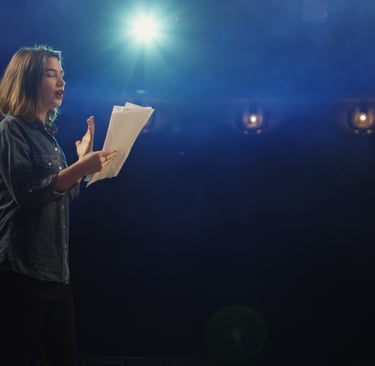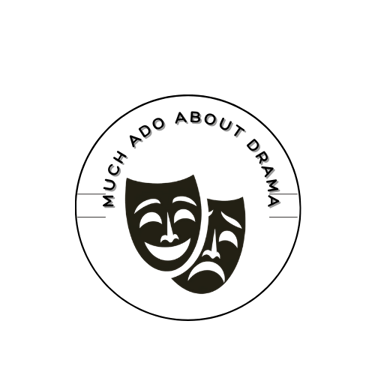Teaching Monologues: Building Confident, Audition-Ready Actors
Teaching monologues doesn’t have to be intimidating. This step-by-step guide breaks down how to help student actors choose, analyze, rehearse, and perform monologues with confidence—perfect for classroom or audition prep.
Katie Zakkak
8/11/20254 min read


When I was a student, monologues were one of the most dreaded parts of acting class. Standing up there, alone, no scene partner to bounce off of, no one to rescue you if you blanked. It was just plain scary.
And yet, monologue work is one of the most important skills a student actor can develop.
Whether or not your students like monologues, the truth is:
🎭 They need to learn them.
🎭 They need to practice them.
🎭 And they need to build confidence doing them.
That’s exactly why I created my Monologue Unit—a complete, ready-to-go resource that walks students through how to choose, analyze, rehearse, and perform monologues with confidence.
✨ You can check out the full unit right here, and don’t forget to sign up for the Drama Teacher Toolkit to get updates and free tips delivered to your inbox.
Why Monologue Work Matters
Monologues are a standard in auditions
Whether it’s a school play, community theatre, or a college audition, most serious actors will be asked to prepare at least one monologue—sometimes more. Students who develop a repertoire early will have a huge advantage.
They build deep character work
In just 1–2 minutes, students must:
Demonstrate their character’s objective and motivation
Track an emotional journey
React to unseen scene partners
Use physicality and vocal technique with intention
It’s an intensive crash course in acting—and a skill that pays off in all performance work.
They grow confidence and independence
Let’s be honest: being up there alone is intimidating. But when students face that fear and perform solo with strength, the confidence they build is transformational—on stage and off.
How I Teach Monologue Work in the Classroom
Here’s the structure I follow in my classroom—and what’s built into my Monologue Unit resource:
1. Choosing the Right Monologue
I guide students to find pieces that are:
Age-appropriate
Emotionally accessible
Roles they could be reasonably cast in
I’ll update this post with a list of my favorite sources soon—but in the meantime, students are encouraged to read widely, and I help them select something that suits their strengths and stretches them just enough.
Here are some free or low-cost places to find monologues:
Backstage.com – Teen Monologues
Offers curated monologues specifically for teens, with sections for dramatic, comedic, Shakespeare, Disney, etc.
Examples include "8 Contemporary Monologues for Teens" (June 12, 2025), "6 Shakespeare Monologues for Teens" (Mar 2024), and short audition‑ready pieces like
All are permission‑cleared for classroom or audition use, and many include direct links to the text.
Drama Notebook – Free Monologues for Teenagers
Monthly contest winners, original pieces written by youth aged ~6‑18.
Freely usable in educational settings, auditions, and school performances as long as the author and Drama Notebook are cited
YouthPLAYS Free Monologues
Nearly one of the largest collections of teen and youth monologues available online for free classroom and audition use.
Browse by genre (drama, comedy, dramedy) and gender; you request pieces via a form—permission response typically in a couple of days
Jonathan Dorf’s Free Monologues
A collection of teen and adult monologues from Jonathan Dorf’s plays, available at no cost for auditions/classroom. You join his email list to gain access.
Don Zolidis – Teen Monologues
Free PDFs of teen monologues from an acclaimed playwright; printable and usable for auditions or classroom projects
2. Contextual Reading
Yes, I require students to read the full play.
Even if they are not fans of the idea, understanding the context is essential.
“What’s happening before this moment? What’s motivating the character? How does this speech fit in the overall arc?”
Without that, the performance is just reciting lines—not storytelling. They need to know what is happening in that exact moment of the character’s life when the monologue takes place. It adds so much more depth to the character and overall performance.
3. Rehearsal and Exploration
We spend time:
Practicing the piece regularly
Trying different emotional interpretations
Blocking and using space intentionally
The rehearsal phase is about discovery as much as it is about memorization. Completing character analysis is a vital part of the process. Every time the monologue is rehearsed, some kind of new realization should be made about the character.
4. Practice Performances with Feedback
Before the final performance, students share their monologues in a low-stakes environment:
Peer feedback
Teacher notes
Discussion of what’s working and what to push further
This step reduces anxiety and builds support among classmates. Before peers offer feedback to one another, it is important to discuss how to give helpful feedback. The best feedback is clear and specific.
Example: Instead of “I liked it. It was funny.” say “When you threw your hands up and sighed loudly on the ‘what’s the point’ I was laughing out loud. It was funny and relatable. I wonder if you could find a few more moments like that throughout. There was a little less energy toward the end of the piece.
5. Final Performance and Assessment
After feedback and adjustments, students perform their final monologues with confidence.
I use a clear rubric that’s provided from day one of the unit. Students always know what they’re working toward—and how they’ll be evaluated.
The rubric and all supporting materials are included in my Monologue Unit, available here.
Final Thoughts
Monologue work can feel intimidating—for students and teachers—but when broken down step by step, it becomes one of the most rewarding parts of the drama classroom.
You’re not just preparing your students for auditions.
You’re building actors who are confident, articulate, expressive, and self-aware.
If you’re ready to make monologue work more approachable and impactful, check out my Monologue Unit, and don’t forget to sign up for the Drama Teacher Toolkit to get tips, freebies, and product updates straight to your inbox.
Happy teaching—and break a leg!
